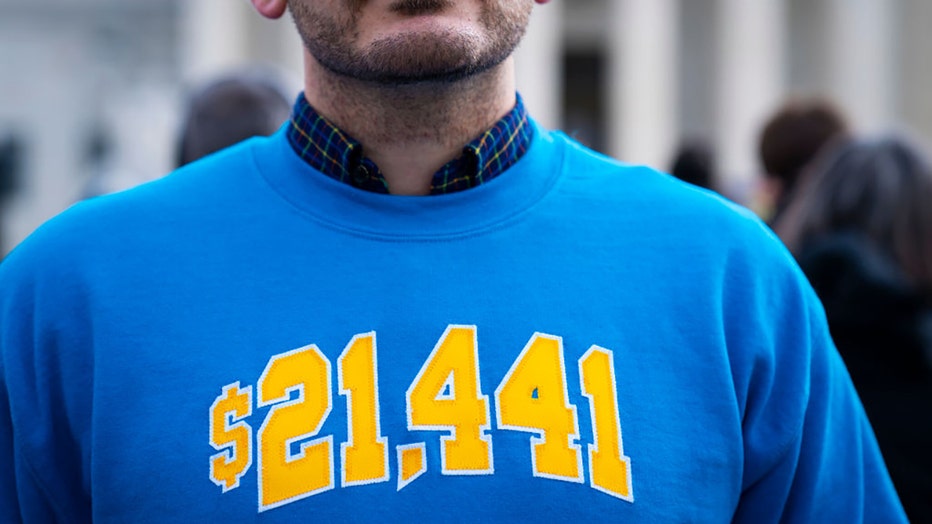Here are the states where student loan delinquency is increasing the most
With student loan payments having resumed over the past year following a pause during the pandemic, many people have struggled to keep up.
A new report from WalletHub, published on Thursday, analyzed where student loan delinquency, or letting the loans become past due, is increasing the most by state.
It found that Maine, Louisiana and Michigan have experienced some of the biggest increases in student loan delinquency between the first and second quarters of 2024.
Being delinquent on student loans can lead to damaged credit scores – and even the garnishment of wages.

FILE - An executive director with the Student Debt Crisis Center poses for a photo in a sweatshirt with the amount he owed in student loans to his college during a protest in support of student debt cancellation outside of the Supreme Court of the Un
The report comes amid legal back and forth over the Biden administration’s various plans for student loan forgiveness, which has faced challenges from Republican-led states and previously been blocked by the Supreme Court.
Here's what to know about student loan delinquency and where it's increasing the most:
What’s the difference between student loan delinquency and default?
The first day after missing a student loan payment, the loan becomes past due – or delinquent. The loan remains delinquent until the borrower repays the past due amount, or makes other arrangements like deferment, forbearance, or changing repayment plans.
Loan servicers will report the delinquency to the three major national credit bureaus for those who are delinquent on their student loan payment for 90 days or more.
Anyone who continues to be delinquent on their loan can risk going into default – which can have serious consequences.
This includes the entire unpaid balance becoming immediately due, damaged credit rating and ability to buy a car or house becoming impacted, and even tax refunds and federal benefit payments possibly being withheld and applied toward repayment of the defaulted loan. Wages can even be withheld and sent to the loan holder, the Education Department explains.
The point when a loan is considered to be "in default" varies based on the type of loan it is, the department adds.
"Being delinquent on student loans has the potential to ruin your finances and your credit score, but if you’ve only recently become delinquent you do have time to get back on track," WalletHub Editor John Kiernan said in a statement.
"Federal student loans don’t get reported to the credit bureaus as delinquent until you’re 90 days behind on payments, though private loans may report delinquency after as few as 30 days," Kiernan added. "If you’re having trouble paying, it’s important to contact your lender as soon as possible to try to work out a solution."
Where student loan delinquency is increasing
Student loan delinquency has increased the most in Maine, according to the WalletHub report – which found that the state’s residents were delinquent on 32.2% more student loans in Q2 2024 compared to Q1 2024.
Interestingly, WalletHub noted how Maine only ranks 34th among the states where people have the most student loan debt. Additionally, the average student loan payment in the state is just $182 per month, which is the 23rd-highest in the U.S.
However, Maine ranks fourth among the states where consumer debt is increasing the most, WalletHub said – and other types of borrowing "are clearly making it harder to keep up with student loan payments."
- Maine 32.15%
- Louisiana 17.31%
- Michigan 17.06%
- Rhode Island 15.73%
- North Carolina 15.52%
- North Dakota 15.17%
- Delaware 14.50%
- Georgia 10.18%
- Nebraska 8.65%
- New Hampshire 7.93%
- New Jersey 6.66%
- California 6.52%
- Illinois 6.50%
- Mississippi 6.40%
- Massachusetts 5.43%
- Hawaii 5.42%
- Kansas 5.37%
- Florida 4.17%
- Tennessee 3.92%
- Wisconsin 3.66%
- Indiana 2.80%
- Alabama 2.64%
- Arizona 2.56%
- Pennsylvania 2.52%
- Arkansas 2.15%
- South Dakota 0.91%
- Ohio 0.86%
- Maryland 0.67%
- Oregon 0.52%
- Texas -0.04%
- Kentucky -1.14%
- Virginia -1.40%
- New York -1.99%
- Oklahoma -2.33%
- Connecticut -2.46%
- Utah -2.94%
- South Carolina -3.03%
- Nevada -3.80%
- Minnesota -4.08%
- Colorado -5.04%
- Iowa -5.62%
- Montana -7.50%
- Missouri -9.23%
- West Virginia -9.93%
- Alaska -12.99%
- Washington -13.93%
- New Mexico -16.39%
- Wyoming -18.58%
- Idaho -22.34%
- Vermont -30.03%

